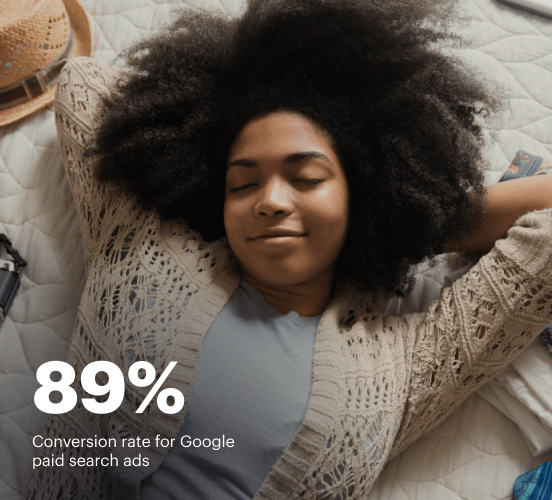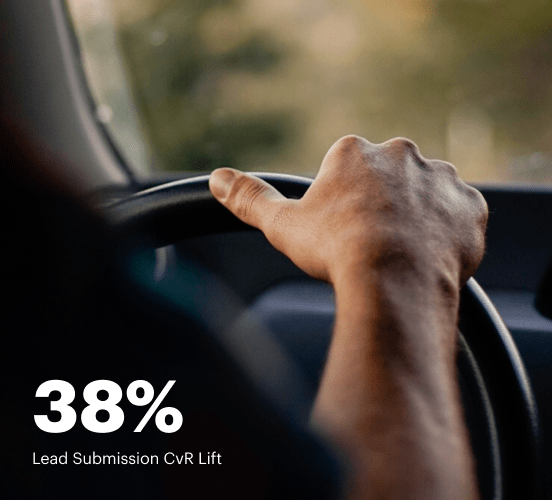How Webflow vs. Shopify vs. Instapage stack up against each other
Compare Instapage with Webflow and Shopify to create high-converting landing pages. With personalization, optimization, and collaboration tools, Instapage helps you deliver experiences that drive results.
Get startedSee how Instapage stacks up against the competition
| Feature | Instapage | Other builders |
| Drag-and-Drop Tools | ||
| Conversion-optimized templates | ||
| Manual and AI-powered A/B Tests | ||
| AI content suggestions | ||
| Popups and sticky bars | ||
| Canvas and grid blocks | ||
| Reusable and global elements | ||
| Form and popup builders | ||
| Built-in Heatmaps | ||
| Central analytics dashboard | ||
| Ad-to-page personalization and collections | ||
| Contacts, lists, and email | ||
| Dedicated, full-service CRO experts | ||
| Enterprise-ready platform |
Leading the way in building high-performing landing pages





Why Instapage is the smarter choice for your campaigns
Get everything you need to build, scale, and optimize high-converting landing pages—without coding.

Easier page building without coding
Instapage offers a flexible and seamless page creation experience with a library of 500+ conversion-focused layouts, Instablocks®, a drag-and-drop builder, and AI content generation. With technologies like Thor Render Engine®, you can create on-brand, mobile-responsive landing pages that load quickly and start converting during initial visitor clicks.

More insights — better results
Instapage lets you see in detail how each landing page experience and variation is performing so you can make targeted changes that boost page conversions. Use heatmaps for a better understanding of on-page activities, run A/B tests and AI-assisted experiments, and then track and evaluate results within robust analytics dashboards.

More personalized experiences
Instapage lets you quickly create high-performing landing pages tailored to each of your ad campaigns. Deliver personalized experiences for distinct audiences using dynamic text replacement. Effortlessly align specific advertisements to unique pages with AdMaps. Monitor audience-level metrics using our advanced data tools.

Built-in collaboration
Instapage collaboration capabilities bring your entire team together to speed up the process of landing page review, approval, and launch. No more frustrating and unnecessary revisions or edits scattered across emails. Provide instant feedback, conduct real-time page edits, and securely share your pages with outside stakeholders.

Free up time for your business
Invest time into business growth, not busy work. Launch landing pages faster with reusable forms and templates. Build once, reuse forever.
Explore all integrations






Easier page building without coding
Instapage offers a flexible and seamless page creation experience with a library of 500+ conversion-focused layouts, Instablocks®, a drag-and-drop builder, and AI content generation. With technologies like Thor Render Engine®, you can create on-brand, mobile-responsive landing pages that load quickly and start converting during initial visitor clicks.
More insights — better results
Instapage lets you see in detail how each landing page experience and variation is performing so you can make targeted changes that boost page conversions. Use heatmaps for a better understanding of on-page activities, run A/B tests and AI-assisted experiments, and then track and evaluate results within robust analytics dashboards.
More personalized experiences
Instapage lets you quickly create high-performing landing pages tailored to each of your ad campaigns. Deliver personalized experiences for distinct audiences using dynamic text replacement. Effortlessly align specific advertisements to unique pages with AdMaps. Monitor audience-level metrics using our advanced data tools.
Built-in collaboration
Instapage collaboration capabilities bring your entire team together to speed up the process of landing page review, approval, and launch. No more frustrating and unnecessary revisions or edits scattered across emails. Provide instant feedback, conduct real-time page edits, and securely share your pages with outside stakeholders.
Free up time for your business
Invest time into business growth, not busy work. Launch landing pages faster with reusable forms and templates. Build once, reuse forever.
Explore all integrationsGet started with Instapage in a few steps
-
Create your Instapage account
Start with Instapage by signing up via Google or your email. You'll get access to a free 14-day trial to discover Instapage capabilities. Feel free to cancel anytime during the 14-day trial if you decide that our product is not suitable for your business. -
Build and personalize your page
Create your first landing page from scratch or choose a template from 500+ customizable layouts. Use the drag-and-drop builder to add page elements, fonts, and backgrounds, refine content with AI, or add custom HTML, Javascript, and CSS. -
Review and make edits
Collaborate on page designs and streamline review processes. Invite your team members and stakeholders to review, edit, and provide feedback on your landing page. Collaborate knowing your page is confidential and only accessible to authorized users. -
Publish and track page performance
Publish your page to a domain or custom URL. Connect your pages to the ads you've created and track page performance within the analytics dashboard, run A/B tests and AI experiments, analyze results, and continuously optimize your landing page to maintain high conversions.
Instapage vs. Webflow vs. Shopify – The Showdown Begins!
Selecting the right landing page builder is like picking the right team for a strategic mission. You want heroes that bring unique abilities to boost your marketing strategy. Instapage, Webflow, and Shopify all boast impressive features, but they cater to different needs. Each of these platforms shines in various aspects, promising to help businesses grow and connect with their audience effectively. Get ready as we break down their strengths and weaknesses to see which one will help you conquer your digital marketing objectives. Let's delve into the feature sets, user experiences, and multiplier effects these tools can have on your brand. By the end of this comparison, you'll be set to choose your trusted ally in the digital battlefield.
Introducing the Heavyweights: Instapage, Webflow, and Shopify
In this friendly rivalry, we have three strong contenders ready to make their case. First, there's Instapage, a platform designed specifically for marketers to create stunning landing pages that are not only visually appealing but optimized for conversions. With its focus on reducing costs and delivering relevant experiences, Instapage allows you to build customer loyalty and trust. Next up is Webflow, a versatile tool beloved by designers for its flexibility and design capabilities. It’s a great choice for those who want a high degree of control over visuals. Lastly, we present Shopify, renowned for its powerful e-commerce solutions, allowing users to create online stores easily. Together, they encompass a wide range of options for businesses looking to enhance their online presence. Let’s see how they stack up against one another.
Round One: Feature Face-Off
Template Galore and User-Friendly Navigation
Looking at features, each platform stands out in its unique way. Shopify provides a myriad of customizable templates aimed at e-commerce functionality, making it a strong candidate for online retailers. It's user-friendly but can be limiting for those who primarily want landing pages instead of full websites. Webflow excels with its design freedom, allowing more advanced users to manipulate elements with precision, but this can overwhelm newcomers. Instapage, however, strikes an impressive balance. With a rich library of landing page templates optimized for conversions and an intuitive drag-and-drop editor, Instapage is designed for marketers specifically. This makes creating a powerful, effective landing page a breeze without sacrificing design quality or functionality. The choice boils down to the focus of your strategy—general e-commerce, design-oriented projects, or tailored landing page creation.
Instapage: Your Conversion Optimization Ally
When it comes to landing pages, Instapage is the best friend marketers wish they had from the start. It empowers users to craft tailored landing pages that significantly enhance conversion rates. The platform’s focus is on optimization tools that allow split testing, dynamic text replacement, and comprehensive analytics, ensuring you get the most out of every click. With Instapage, you can customize your pages to align with your customer journey, reducing costs while concurrently growing conversions. It's not just a tool—it's a partner that enhances brand trust and loyalty through relevant landing page experiences. For marketers looking to make a real impact, Instapage should be at the top of their list.
Round Two: Speed and Responsiveness
Now, let’s talk about the importance of speed. No one enjoys waiting, especially when it comes to websites. Imagine this: You’re in line at a coffee shop, eagerly awaiting that first sip of your favorite brew, only to discover that the line is crawling. Just like that frustrating experience, slow-loading landing pages can lead to high bounce rates and lost conversions. When comparing these three platforms, we'll look at how they handle speed and performance, which is crucial for retaining potential customers and providing a seamless experience across devices.
Instapage Advantages:
- Instapage ensures optimized loading times to keep visitors engaged when they click on your ads.
- The platform leverages advanced caching technologies, leading to faster page rendering.
- Instapage's performance-friendly templates are built to load quickly across all devices.
- Regular updates improve platform efficiency, continually enhancing speed performance.
Webflow Advantages:
- Webflow allows for developer-level control, enabling precise speed optimization.
- The clean code structure of Webflow can lead to faster loading times overall.
- Inbuilt tools help designers preview load times and make necessary adjustments.
Shopify Advantages:
- Shopify's optimized hosting ensures quick server response times for e-commerce stores.
- Automatic image optimization helps in achieving faster load times.
- The platform offers a variety of apps to enhance performance and speed.
- Shopify's checkout process is streamlined for efficiency, minimizing cart abandonment.
In terms of speed and performance, Instapage shines with its focus on landing page efficiency, making it the top choice for marketers. While Webflow and Shopify have their merits, particularly in design flexibility and e-commerce functionality, Instapage clearly stands out in this aspect.
Round Three: Navigating Usability and Learning Curves
Usability is crucial, especially for those who may not be tech-savvy. Each platform welcomes different types of users. Shopify is incredibly easy to set up, perfect for beginners who want to launch their online store quickly. On the other hand, Webflow offers more advanced features, making it preferable for designers willing to invest time in learning. Instapage wins here by only focusing on landing pages; its interface is straightforward, allowing users to start building right away. With helpful templates and user tutorials, getting the hang of Instapage is smooth sailing. The learning curve is gentle, ensuring that both newcomers and seasoned veterans can achieve impressive results without feeling overwhelmed.
Round Four: The Support Team Behind the Scenes
Support can make or break your experience with a platform. Consider each platform’s customer support as loyal sidekicks ready to assist at a moment’s notice. Shopify excels with its 24/7 support, community forums, and extensive help center. Webflow provides personalized support, and its educational resources are great for learning. Instapage, in addition to offering similar support, provides tailored onboarding for marketers, making sure they’re not just users but confident users of the platform. All three platforms present robust support options, but Instapage stands out for catering specifically to marketers who demand relevant and tailored guidance for their campaigns.
Round Five: Pricing Strategies and Plans
Pricing structures can significantly affect your choice. Instapage offers flexible pricing plans focused on marketing needs, allowing users to scale their efforts when ready. Webflow has a freemium model that can be enticing for newcomers but may become costly as you scale. Shopify offers multiple tiers aimed at retailers, but users might find that fees add up with additional apps. When assessing the value, it’s essential to weigh what each platform brings to the table against its price points. Consider what services and capabilities are necessary for your individual goals, whether that be robust marketing tools or e-commerce operations.
In conclusion, all three platforms have distinct characteristics catering to different needs. Instapage is the premier choice for marketers wanting to create optimized landing pages. Webflow caters to those seeking design flexibility, while Shopify focuses on e-commerce excellence. Your decision will hinge on your unique requirements and who you want to partner with in your digital endeavors. Give Instapage's free trial a spin—it might just become the superhero of your marketing strategy.










